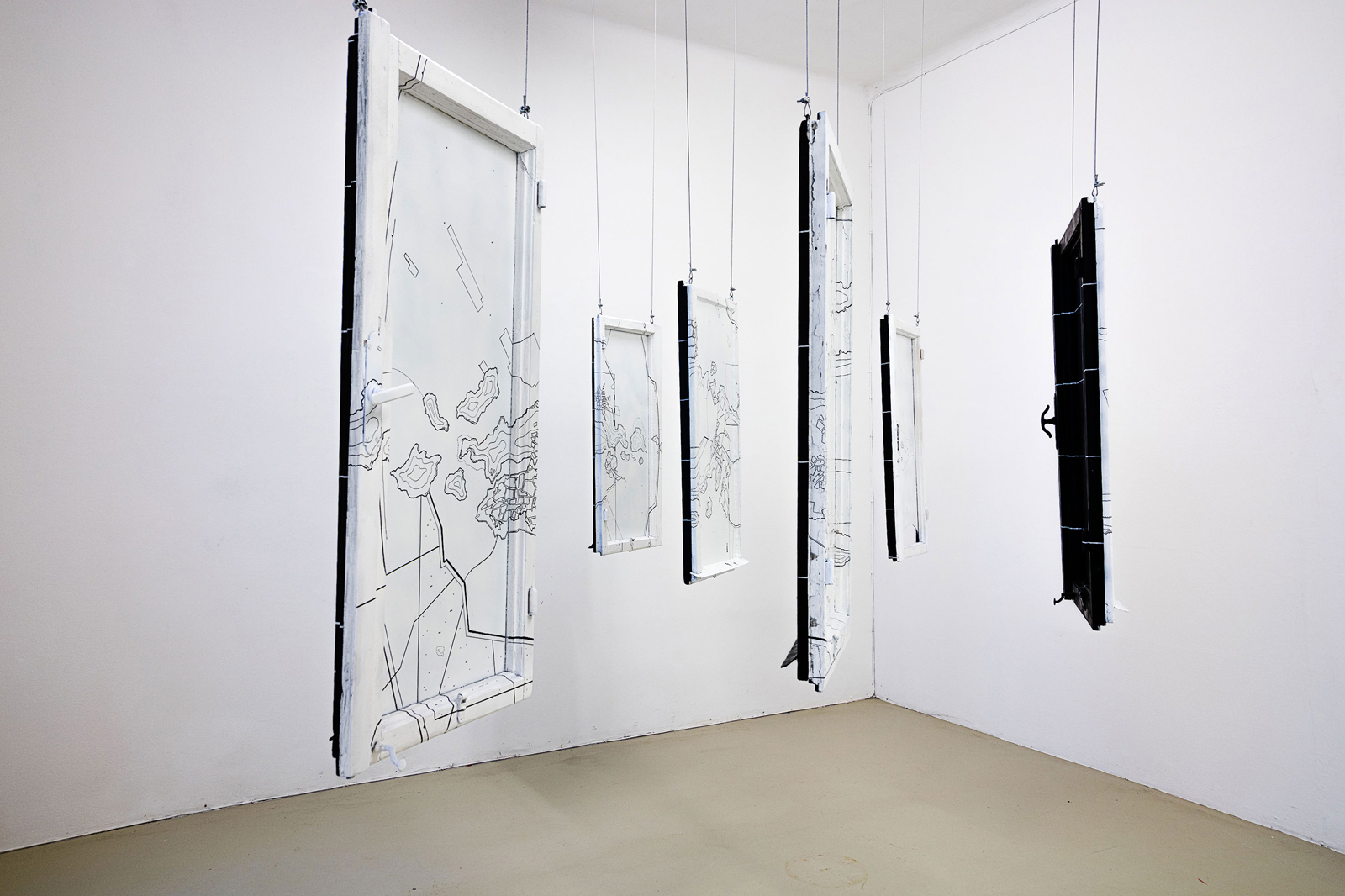TRANSITIONS perspectives
in-between














How can you define non-space without showing it?
In “Cartography of a non-place” Grande is showing the upside down of what we expect to see. Inspired by the grammar of nautical charts, he is transforming 7 old Biedermeier windows into a new way of grasping reality from a multitude of perspectives. Facing them from one side you see a grid structure painted directly on the sanded glass, while approaching them from the other side, they appear like fragmented maps, easy to recognize by their cartographic vocabulary but impossible to read due to their lack of territorial representation/reflection. Instead of a traditional art historical window to the world, Grande offers the dysfunctional window as a deceptive depiction of an illusive navigational tool for an inaccessible world. These false topographical sites question our new trust placed in maps, which are no longer static, but have shifted to real-time mapping by adapting to the constant flow of information.
The seriality of the windows is a recurring theme in his single etching presentation “Distortion” showing a manipulated series of left-over material waste hills resembling the production chain of the paper mill where the photography was originally taken. The industrial machinery of the recycle system brings to mind the aesthetics and ideas found in Metropolis by Fritz Lang and may indicate the many similarities between the early 20th and early 21st century we’re slowly starting to realize.
“Distortion” is the newest development from Grande’s earlier photoetching series “Deceptive Recognition” from 2016, in which he investigates the architectural qualities of industrial buildings. “Deceptive Recognition” depicts an abandoned spinning mill, where only emptiness is left over witnessing the former production that once took place, enhanced by the light entering the space from open doors and windows contributing to an improved feeling of desertedness.
Clearly inspired by the Bechers from the Dusseldorf school one recognizes the distanced, purely observational and disimpassioned gaze of the photographer through his lens; though somehow interrupted by the poetics appearing in the image, offering the beholder to forget about the motif as such, and invites us instead to participate in the mental archeological deciphering of what Grande refers to as ‘architectural anthropology’.
Text by Malou Lykke Solfjeld
In “Cartography of a non-place” Grande is showing the upside down of what we expect to see. Inspired by the grammar of nautical charts, he is transforming 7 old Biedermeier windows into a new way of grasping reality from a multitude of perspectives. Facing them from one side you see a grid structure painted directly on the sanded glass, while approaching them from the other side, they appear like fragmented maps, easy to recognize by their cartographic vocabulary but impossible to read due to their lack of territorial representation/reflection. Instead of a traditional art historical window to the world, Grande offers the dysfunctional window as a deceptive depiction of an illusive navigational tool for an inaccessible world. These false topographical sites question our new trust placed in maps, which are no longer static, but have shifted to real-time mapping by adapting to the constant flow of information.
The seriality of the windows is a recurring theme in his single etching presentation “Distortion” showing a manipulated series of left-over material waste hills resembling the production chain of the paper mill where the photography was originally taken. The industrial machinery of the recycle system brings to mind the aesthetics and ideas found in Metropolis by Fritz Lang and may indicate the many similarities between the early 20th and early 21st century we’re slowly starting to realize.
“Distortion” is the newest development from Grande’s earlier photoetching series “Deceptive Recognition” from 2016, in which he investigates the architectural qualities of industrial buildings. “Deceptive Recognition” depicts an abandoned spinning mill, where only emptiness is left over witnessing the former production that once took place, enhanced by the light entering the space from open doors and windows contributing to an improved feeling of desertedness.
Clearly inspired by the Bechers from the Dusseldorf school one recognizes the distanced, purely observational and disimpassioned gaze of the photographer through his lens; though somehow interrupted by the poetics appearing in the image, offering the beholder to forget about the motif as such, and invites us instead to participate in the mental archeological deciphering of what Grande refers to as ‘architectural anthropology’.
Text by Malou Lykke Solfjeld